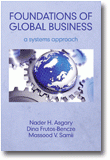
Foundations of Global Business
A Systems Approach
By:
Nader H. Asgary, Bentley University
Dina Frutos‐Bencze, Saint Anselm College
Massood V. Samii, Southern New Hampshire University
Published 2015
In the past three decades a number of important changes have made international business more complex and exciting. The rapid and continuous changes in information and communications technology (ITC), reduced trade barriers among countries, and regionalization have increased the links and dependency among firms from various countries. This has created opportunities for increasing expansion to new markets and increasing global integration while simultaneously posing many challenges.
This book views international business as a complex and integrated system and takes a systems approach to study and analyze the changes thus enabling readers to assess global business opportunities and risk in a comprehensive and integral manner. The topics presented in this book allow practitioners, scholars, and students of international business to have a broad understanding of the most relevant issues in a changing international environment.
CONTENTS
List of Figures. List of Tables. Introduction: Foundations of Global Business: A Systems Approach. Dynamics of Systems in Global Business. Analysis of International Business: Systems Approach. Internal–External Systems. Dynamic Elements of International Business. System Dynamics Language. Causal Loop Diagrams. Chapter Descriptions. SECTION I The Institutional Structure of International Business. Globalization and Political‐Economic Transformation. Debate on Globalization. Pros. Cons. Globalization and Institutional Factors. Nongovernmental Organizations (NGOs). Challenges of our Generation. The Global System. The Political System. The Economic System. Transition Economies. Sociocultural System. The International Trade System. The Global Trade System. Free Trade. Trade Theories. Theory of Absolute Advantage. Theory of Comparative Advantage. Factor Proportion Theory. Benefits of Trade. Reasons for Government Intervention. Tariff and Nontariff Barriers’. Impacts. Nontariff Barriers. The International Institution of Free Trade: WTO. Fair Trade. Conclusion. Note. Economic Integration. Economic Integration through Regionalization. Types of Trade Agreements. Winners and Losers from Economic Integration. NAFTA. CAFTA‐DR. Debate. The European Union. The Treaty of Maastricht. Convergence Criteria. Key EU Institutions. European Monetary Institute (EMI). European System of Central Banks. (ESCB). European Central Bank (ECB). Major Problems. The 2010 European Sovereign Debt Crisis. Causes of the Greek Government Funding Crisis. The Global Financial System. Global Financial Institutions. The International. Monetary Fund. The World Bank. International Banks. Global Private Investment Funds. Global Financial Markets. Foreign Exchange Market. Spot Exchange Rate. Exchange Rate Determination. Supply and Demand for Currency. Capital Flow. Complete Exchange Rate Model. The Forward Market. The Global Equity Market. The Global Debt Market. Impact of the Global Financial System. Parity Condition. Purchasing Power Parity (PPP). Conclusion. Note. SECTION II Firm Level International Business. International Business Strategy. Analytical. Approach: Tripod Strategy. Tripod Model Extended. International Business Strategy: 5 W Model. Topology of Operational Strategies. Internalization Theory. Location Selection. Choice of Location for Expansion. Location Selection for a Firm Established in the Country. Quantitative Indices for Countries. Ease of Doing Business. Economic Freedom Index. Corruption Perception Index. Clusters as Location. Dynamics of Location Advantage. Change. Notes. The Internationalization Process of a Firm. Value Creation Through International Business. Revenue Enhancing Through a Market Seeking Strategy. Cost Minimization Through a Resource‐Seeking Strategy. Competitive Positioning. Following Customers or Suppliers. Avoiding Government Regulation. Other Benefits to Internationalization. The Process of Going International. Export–Import. Licensing. Franchising. Outsourcing and Strategic Alliances. Joint Venture. Wholly Owned Subsidiary. Cross‐Cultural Management. Culture and Global Management. Defining Culture. Global Mindset and Managerial Skills. Personal Integrity and Global Mindset. Challenges of Operating Globally. Managing Change in Global Organizations. Conclusions. Corporate Social Responsibility and Environmental Sustainability. Corporate Social Responsibility. Arguments For and Against Corporate Social Responsibility. Contemporary Social Issues. Environmental Issues. Global Issues. Technology Issues. Sustainable Development. Sustainability Assessment. Environmental Sustainability. Criteria for Environmental Sustainability. Country Level Sustainability. Sustainability at the Firm Level. GRI Reporting Framework Dimensions. References.
-
Paperback9781681232683
Web price: $45.04 (Reg. 52.99)
-
Hardcover9781681232690
Web price: $80.74 (Reg. 94.99)
- eBook9781681232706

- BUS000000 - BUSINESS & ECONOMICS: General
- BUS035000 - BUSINESS & ECONOMICS: INTERNATIONAL: General
- BUS020000 - BUSINESS & ECONOMICS: DEVELOPMENT: Business Development
-
 European Entrepreneurship Research and Practice
A Multifaceted Effort Towards Integration of Different Perspectives
European Entrepreneurship Research and Practice
A Multifaceted Effort Towards Integration of Different Perspectives
-
 Managing Interpartner Cooperation in Strategic Alliances
Managing Interpartner Cooperation in Strategic Alliances
-
 Managing the Partners in Strategic Alliances
Managing the Partners in Strategic Alliances
-
 Multi-Sector Partnerships for the Public Good
Multi-Sector Partnerships for the Public Good
-
 Organization Development in the Largest Global Organization
The History of OD in the U.S. Military
Organization Development in the Largest Global Organization
The History of OD in the U.S. Military
-
 The Entrepreneurship SIG at the European Academy of Management
Setting the Base for Tomorrow's Challenges
The Entrepreneurship SIG at the European Academy of Management
Setting the Base for Tomorrow's Challenges
-
 The Plight of Stigmatized Groups in Organizations
The Plight of Stigmatized Groups in Organizations

